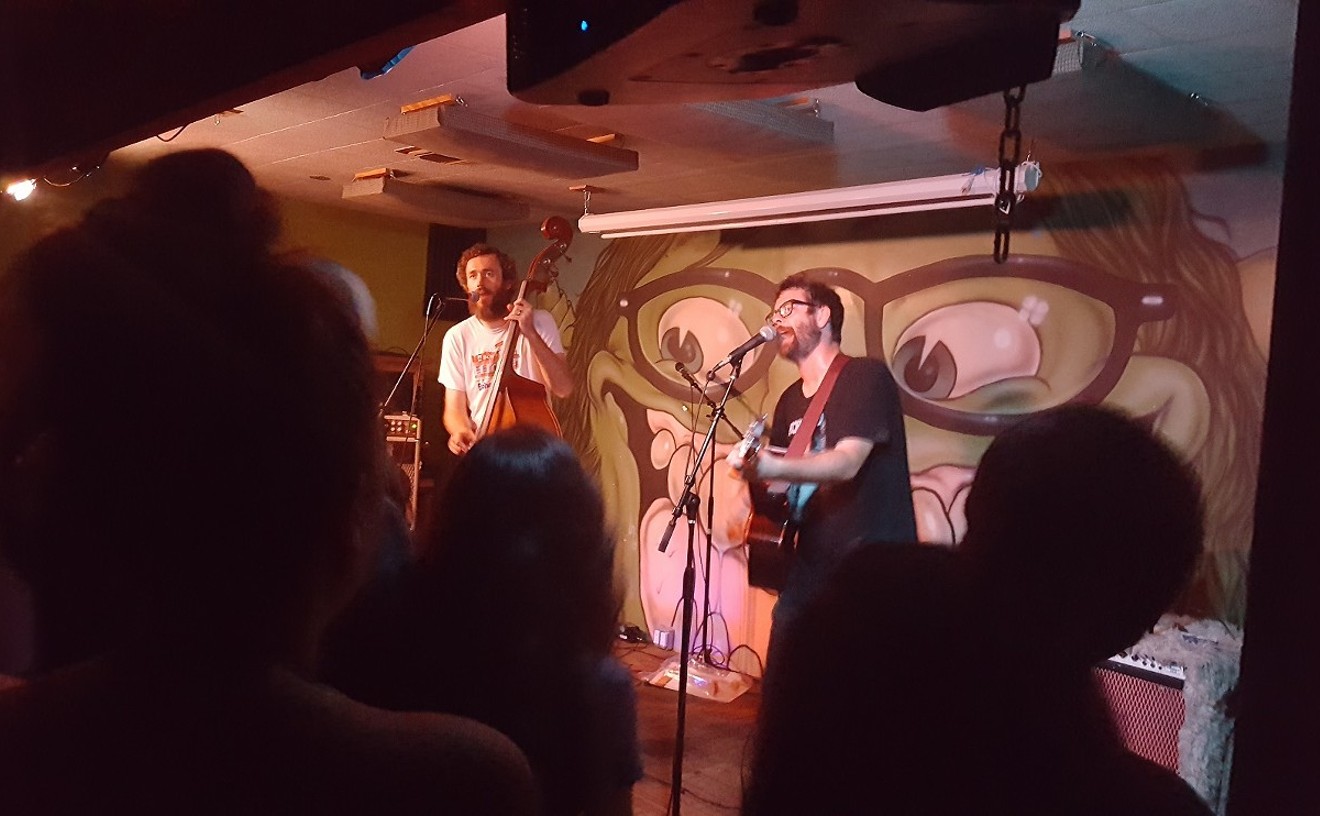Benavides' "Madonna" is a 17-foot-tall, fully drivable shrine to Our Lady of Grace--a sort of lowrider-meets-high-art piece of movable sculpture. Her flowing veil, dress and mantle, into which headlights have been tucked, are formed entirely out of license plates from almost every state in the Union. Most are blue and white or cream, the colors most often associated with the Virgin, though Benavides says he settled for some red ones after he'd exhausted the supply of blue plates available from his relatives, friends and sundry junkyards and swap meets.
"License plates are legal documents that represent people," Benavides says, enthusing about the symbolic potential of his unconventional medium. "Behind each of them, there's a family or an individual that might have had a flat, might have been robbed, might have gone to Disneyland, might have gotten married. I don't know what their stories are, but I have the evidence of their stories right here."
The Datsun chassis also has a tale. After searching the classifieds for weeks, the artist bought it for $700 from an ex-convict who had had his driver's license revoked and couldn't get the pickup legally registered.
Benavides made his crowd-stopping sculpture in the course of completing studies for a Master of Fine Arts degree at Arizona State University. An aerospace engineer who worked for six years at California's China Lake Test Center, he used to help develop missiles and warheads for the U.S. Department of Defense. After layoffs that came with defense cuts in the late '80s, he returned to school. Now he's merging his engineering and art training to make sculpture.
The 47-year-old Latino artist says he has a built-in affinity for the Virgin Mary--he was born on December 8: the Feast of the Immaculate Conception. To find a model for his car sculpture, he searched among the classic images of the Virgin and chose Our Lady of Grace because she provided a key design solution.
Our Lady of Grace is usually depicted as pregnant, says Benavides, a practicing Catholic. "I was not that knowledgeable about the Lady of Grace before I started this project," he says, "but this car's gotta have a driver's compartment, right? Where's the driver's compartment gonna be? At her chest? At her feet?" Heavy with child, the Virgin belly offered a perfect site for the driver's seat.
"That's what made me decide on her, rather than the Virgin of Guadalupe," says Benavides. "Besides, I wasn't sure how to handle the rays," he adds, referring to the aura typically radiating from images of the Virgin of Guadalupe, the popular Mexican archetype of the Virgin Mary.
The serene face and expressive, outstretched hands of the vehicular Virgin are carved from lightweight Styrofoam painted to look like cast aluminum. Weight was an important factor in creating her, since the Queen of Heaven also serves as the door to the driver's area. But, unlike a conventional car door, which opens sideways, she must be flipped forward electronically, head first, to a 30-degree angle in order to allow a driver to squeeze in. Once the driver is seated in the cramped compartment, which is outfitted with a tiny steering wheel and brake and clutch pedals, the metal Virgin is lowered for takeoff.
So far Benavides alone has driven the masterpiece, but others can get into the act. With a little muscle from a couple of acolytes armed with poles, the Virgin can be raised completely upright, turning the sculpture from a static object into a piece of performance art that calls to mind a religious procession. And, once upright, instead of resting on a crescent moon like the "Immaculate Conception" does, or on the heads of cherubs like other manifestations of Mary, the wheeled Madonna ends up resting on a funky front grill.
While the license plates Jose Benavides has used for his saintly sculpture may have complied with the law at one time or other, his artful end product probably never will be considered street legal. Besides being a photo-radar cop's worst nightmare, lack of certain safety features most likely would foil any attempt at having the car declared ready to roll in the legal sense.
"For example, the driver's compartment sits right on the rear axle and the seat is actually attached to the axle," the artist explains. "When you sit and drive it, trying to push the clutch and brake pedals, you're straddling the drive line."
Inspiration for Benavides' project initially came from researching art cars, especially lowrider cars that have become cult objects in the Southwest. Chopped and channeled, often customized with metal flake paint, kitschy hood and trunk murals, small steering wheels made of chromed chain-link and hydraulics that force a car to literally hop heavenward at the flip of a toggle switch, these flamboyantly modified vehicles transcend the merely automotive. The University of Arizona's James S. Griffith, a specialist in southern Arizona folk art, calls them "Low and slow, mean and lean" contemporary statements hearkening back to a baroque aesthetic, which has been a part of both Mexican and Mexican-American culture since the 18th century.
Benavides' car sculpture uses the cultural phenomena of the lowrider car and fervent religious devotion to the Virgin Mary, as well as all those nameless ex-license-plate owners, to make a potent metaphorical statement about the culture to which he's both physically and psychically linked. Each one of those strategically placed plates, like every lovingly customized lowrider car, represents unique personal visions and memories, the unremarkable, everyday stuff from which life and art is most often forged.
But Benavides, the son of migrant farmworkers who moved to Arvin, California, to harvest grapes when he was a child, is insistent that his work rises above stock religious stereotypes. "This is not intended to be a piece about religion or Christianity," he says, "even though the images do come from there. This work is about art and culture, even though the images are 'religious.'"
Nor does the sculptor want to be seen solely as a Hispanic or Chicano artist: "I don't particularly care to be pigeonholed as a Chicano artist because that tends to be limiting; yes, I'm Chicano, but I'm getting information from the Anglo community, the black community, from the [East] Indian community. All that information goes into making my art, not just my Chicano background."
At this point, Benavides hasn't started worrying about where he's going to store his movable shrine, which is now parked on campus, after he graduates. That's because "Madonna" has been invited to make a cameo appearance at Phoenix Center Visual Arts Gallery's May 3 opening of "Arte Latino en la Ciudad (Latino Art in the City)," where Benavides will have other work on display. She'll also appear at the opening of an exhibition in June at the Children's Art Museum in Mesa. After that, Benavides may have to clean out his garage.
Benavides continues to work with discarded materials, like the tires he's just used in making an interpretation of "The Last Supper." "I like to reuse things that have served people, such as tires, which are very valuable when you first buy them and then take on a negative value. What do you do with them? I like taking something that's been discarded and giving it new value by putting it in a new situation," the artist says. "It's like grabbing something that's going down the drain and saying, 'Hey, there's beauty to this.'"
Interested in buying Benavides' righteous conveyance for your own collection? "I'm really not interested in selling it right at the moment," the artist claims. "For now I want to get as much mileage out of it as I can. Though I may consider swapping it for an entry-level BMW. A new one."
Jose Benavides' "Madonna" can be viewed in the "Arte Latino en la Ciudad (Latino Art in the City)" exhibit, which opens on Friday, May 3, and continues through Friday, May 24, at Phoenix Center Visual Arts Gallery, 214 East Moreland, Room 203.










